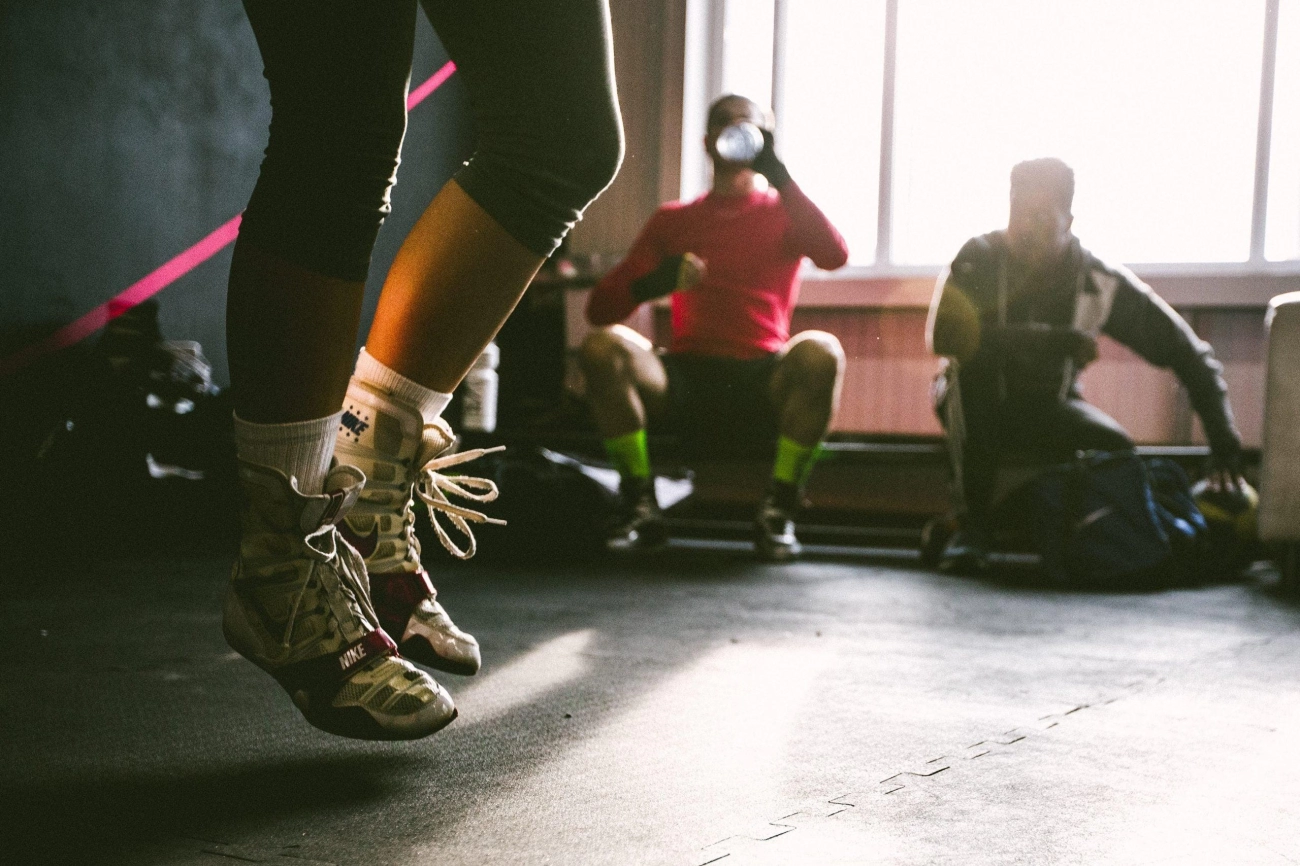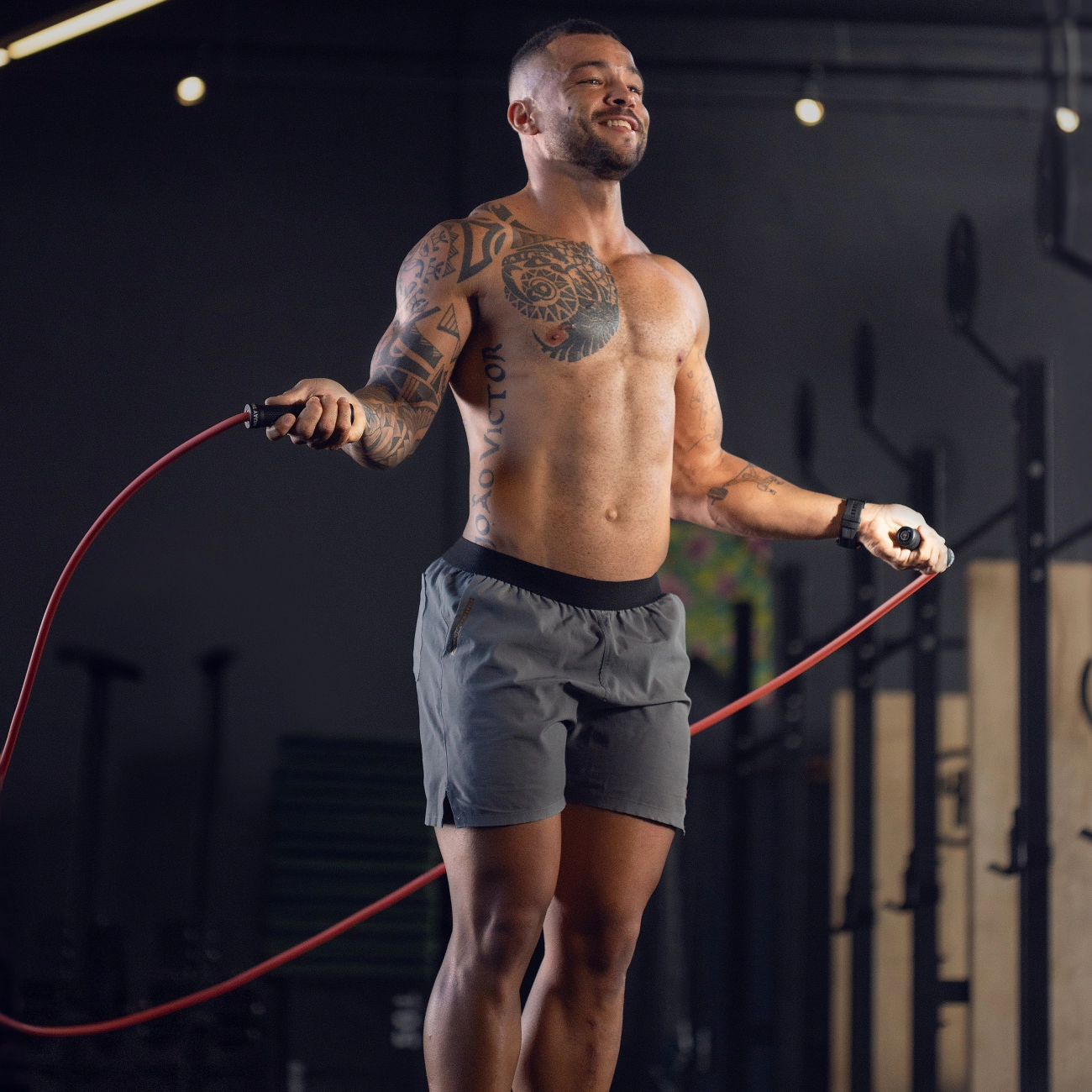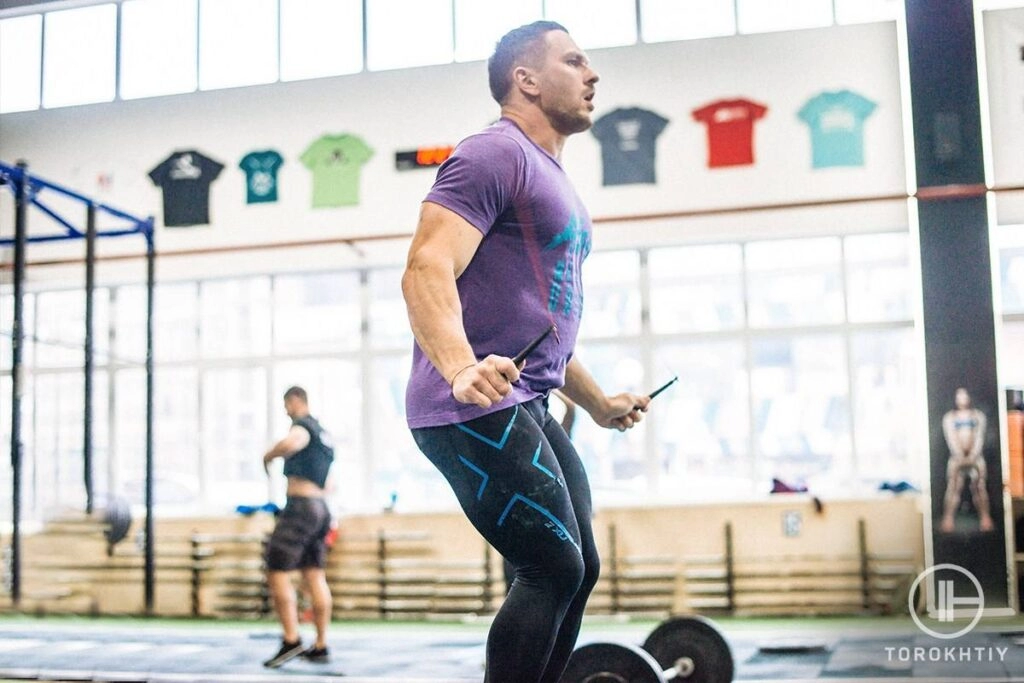What Is a Weighted Jump Rope
A weighted jump rope is a specially designed fitness tool that adds extra resistance to traditional jump rope exercises. Unlike standard ropes, weighted jump ropes feature heavier cords or handles that increase the load during your workout, helping you build strength, muscle toning, and endurance more effectively.
Design Features and Materials
Weighted jump ropes typically have thicker, denser cords made from materials such as PVC combined with added weights like metal cables or sand-filled handles. The PVC options are particularly popular because they provide durability while allowing for smooth rotation and flexibility. Weight variations can range from 1 to 3 pounds or more, depending on your training needs.
- Cord thickness: Often bulkier than speed ropes to support the weight and resistance
- Handles: Ergonomically designed, sometimes cushioned for grip and comfort during intense sessions
- Weighted core: Some ropes contain metal or sand in the handles or the rope itself to enhance resistance
Typical Use Cases for Weighted Jump Ropes
Weighted jump ropes are ideal for users looking to:
- Build upper body and core strength: The added weight engages muscles more intensely
- Tone muscles: Improves muscle definition through resistance training
- Increase endurance: Combining cardio with strength training challenges your stamina
- Rehabilitation and conditioning: Controlled weighted movements can aid muscle recovery
Using a weighted jump rope intensifies every jump, increasing calorie burn and muscle engagement far beyond what an unweighted rope provides. This makes it a versatile option for fitness enthusiasts seeking a comprehensive workout tool that targets both cardiovascular health and muscular development.
For a detailed breakdown of how weighted ropes enhance workout efficiency, you can also visit PVCJumpRope.com benefit of weighted jump rope.
What Is a Speed Rope Jump Rope

A speed rope is a jump rope designed specifically for fast, efficient rotations, helping users boost their jumping speed, agility, and cardio fitness. Unlike weighted jump ropes, speed ropes are built to minimize resistance and maximize RPMs (rotations per minute), making them a favorite among athletes and fitness enthusiasts focused on speed and endurance.
Design Features of Speed Ropes
Speed ropes typically feature thin, lightweight cables that rotate smoothly through ball-bearing handles. This design allows for quicker, more precise swings without extra effort. Handles tend to be slim and ergonomic, often made with a grippy material to prevent slipping during rapid workouts.
PVC and Its Role in Speed Ropes
PVC cables are a key component in many speed ropes due to their lightweight and durable nature. PVC-coated cables offer the perfect balance of flexibility and stiffness, allowing the rope to whip through the air quickly without tangling or slowing down. This material also stands up well to regular use on various surfaces like gym floors or pavement, ideal for those focused on consistency and performance.
Typical Use Cases of Speed Jump Ropes
- Improving speed and footwork: Speed ropes help athletes sharpen foot coordination and quickness, essential for sports like boxing, basketball, and soccer.
- Enhancing agility: The rapid rotation trains the nervous system for better timing and reflexes.
- Boosting cardio conditioning: Fast-paced jumping increases heart rate and stamina, making speed ropes perfect for high-intensity interval training (HIIT) and fat-burning workouts.
- Skill development: Ideal for jump rope training drills that focus on doubles, cross-overs, and other advanced moves.
In short, a speed rope is your go-to tool if your aim is to develop rapid movement, elevate cardio endurance, and refine your jumping technique, especially with the trusted durability and smooth performance of PVC speed ropes.
Weighted Jump Rope vs Speed Rope Key Differences
Weight and Construction Differences
Weighted jump ropes are noticeably heavier, often featuring thicker cables or ropes embedded with materials like steel or sand to add weight. This extra mass helps build strength and muscle tone by increasing resistance with each jump. In contrast, speed ropes use lightweight materials such as thin PVC cables designed for fast rotations. The focus here is on speed and agility, so the rope needs to be light and smooth to turn quickly.
Impact on Workout Intensity and Muscle Engagement
Using a weighted jump rope ramps up workout intensity by forcing your upper body and core to work harder. This leads to greater calorie burn and strength gains, especially in your arms, shoulders, and forearms. On the other hand, a speed rope targets cardiovascular fitness and footwork precision. It’s great for improving agility and endurance but engages less muscle resistance due to its light construction.
Skill Level Considerations for Beginners to Advanced
If you’re just starting out, a speed rope is typically easier to handle because it’s lighter and faster to spin, helping you build rhythm and coordination. Weighted ropes are better suited for intermediate to advanced jumpers who want to add resistance training alongside cardio. Beginners might find weighted ropes challenging as they demand more control and strength.
Rope Length Handle Types and Adjustability
Both weighted and speed ropes come with adjustable lengths, but weighted ropes often have bulkier handles to house weights, offering a firm grip during intense workouts. Speed ropes usually feature slim, ergonomic handles with smooth bearings for fast rotation. Look for ropes with easy-to-adjust lengths—which is essential regardless of rope type—to get the perfect fit for your height.
Durability and Material Comparison with Emphasis on PVC Advantages
PVC plays a key role in both ropes, but in different ways. Speed ropes often use thin, coated PVC cables that strike a balance between durability and lightweight performance. They’re resistant to wear, making them ideal for indoor and outdoor use. Weighted jump ropes might use thicker PVC or combine it with other materials to add weight while still maintaining flexibility. PVC’s durability means these ropes last longer and withstand the frequent, high-impact use common in jump rope training.
In short:
- Weighted jump ropes focus on resistance and muscle engagement with thicker, heavier build.
- Speed ropes emphasize quick rotations and cardio conditioning with lightweight, smooth PVC cables.
- Both rope types feature adjustable lengths and durable handles tailored to their workout goals.
- PVC materials offer the right balance of durability, flexibility, and performance for U.S. fitness enthusiasts in both categories.
Benefits of Using Weighted Jump Ropes

Weighted jump ropes stand out as a powerful tool for anyone looking to boost their workout and get more out of each session. Here are the key benefits that make them a solid choice.
Enhanced Calorie Burn and Fat Loss
Using a weighted jump rope increases the amount of effort your body has to put in during your jump rope workout. The added weight intensifies the exercise, which means you burn more calories in less time compared to a standard rope. This makes weighted jump ropes excellent for those focused on weight loss and fat burning while maintaining a cardio routine.
Improved Upper Body Strength and Coordination
Because weighted ropes require more control and force, they engage your arms, shoulders, and core muscles much more than regular ropes. This leads to better muscle toning and upper body strength over time. Additionally, the resistance helps improve hand-eye coordination and timing, which is essential whether you’re a beginner or an advanced jumper.
Suitable for Strength Training and Rehabilitation
Weighted jump ropes aren’t just for boosting cardio; they can also be used for strength training and rehabilitation. The gradual resistance helps in building muscle endurance and improving joint stability without needing heavy gym equipment. This makes weighted jump ropes a helpful option for anyone recovering from injury or looking to add variety to their strength routine.
Durability and Performance of PVC Weighted Ropes
PVC weighted jump ropes are popular because they offer the best balance of durability and performance. The PVC material is light enough to allow smooth swings yet robust enough to handle the extra weight without breaking down quickly. This means you get a rope that lasts longer and performs consistently, even during intense workouts.
If you want to dive deeper into how weighted ropes ramp up your calorie burn and overall workout effectiveness, check out this detailed guide on the benefits of weighted jump ropes for more insights.
Benefits of Using Speed Ropes for Cardio Fitness and Agility
Speed ropes are an excellent tool if your goal is to boost jumping speed and improve cardiovascular fitness. Thanks to their lightweight PVC design, these ropes allow for rapid rotations that challenge your heart rate, making them perfect for effective jump rope workout comparisons focused on endurance and stamina.
Improve Jumping Speed and Reflexes
Using speed jump ropes helps develop better footwork timing and quick reflexes. The fast pace forces your coordination to sharpen, which is ideal for athletes who rely on agility and fast movements. This makes speed ropes a popular choice for sports training and high-intensity interval workouts.
Perfect for Athletic Training and Agility
Speed ropes are tailored for those looking to enhance agility and explosive power. They’re widely used in boxing, CrossFit, and other performance sports where quick, repeated jumps improve overall movement efficiency.
Advantages of Lightweight PVC Speed Ropes
- Durability: PVC is robust, making speed ropes resistant to wear from intense workouts.
- Smooth Swing: The lightweight material allows effortless spinning, which helps maintain consistency during fast-paced sessions.
- Adjustability: Many PVC speed ropes come with adjustable lengths and comfortable handle types, accommodating different skill levels and workout styles.
With PVC speed ropes, you get a balanced combo of performance and durability, helping you train harder and longer without equipment-related interruptions.
Which One Is Best for You Weighted Jump Rope vs Speed Rope Factors to Consider
Choosing between a weighted jump rope and a speed rope depends on several key factors that link directly to your fitness goals, experience, and workout setup. Here’s what to consider to pick the right rope for your needs.
Fitness Goals Strength vs Speed vs Endurance
- Strength and Muscle Toning: If your goal is to build upper body strength, increase muscle endurance, and burn more calories through resistance, a weighted jump rope is your best bet. The added weight increases workout intensity and muscle engagement.
- Speed and Agility: For improving footwork, quickness, and cardiovascular fitness, especially in sports training or agility work, a speed rope is ideal. These ropes help you develop faster rotations and better timing.
- Cardio and Endurance: Both ropes can boost endurance, but speed ropes offer more efficient cardio conditioning due to their lightweight design and faster rotations.
Current Skill Level and Jump Rope Experience
- Beginners may find weighted ropes easier for developing coordination since the slower speed allows more control.
- Intermediate to advanced users typically prefer speed ropes for skill-building and intense cardio.
- Consider starting with a rope that matches your current skill and progressing as you improve to avoid frustration or injury.
Space and Type of Workout Environment
- Indoor or small spaces: Weighted ropes, generally thicker and slower, require less clearance for fast rotations, making them suitable for limited spaces.
- Open areas: Speed ropes need more room to swing freely at high speeds, so an open workout space is preferable.
- Your workout surface also matters—PVC ropes tend to perform well on smooth surfaces common in gyms and homes.
Budget and Rope Durability
- PVC jump ropes, whether weighted or speed, offer excellent durability and affordability.
- Weighted ropes might have sturdier handle designs and heavier cables, possibly increasing cost slightly but improving longevity.
- Consider investing in a quality rope that lasts longer rather than a cheaper option that wears out quickly.
Personal Preference and Comfort
- Handle grip, rope length adjustability, and rope weight all influence comfort.
- Some prefer the heft of a weighted jump rope for feedback and rhythm, while others like the ultra-light feel of a PVC speed rope for quick responses.
- Test different ropes if possible to find what feels natural to your wrists and hands, improving your workout quality.
To decide between a weighted jump rope and a speed rope, think about your main fitness goal — strength and calorie burn or speed and agility. Match that to your skill level, the space where you train, your budget, and what feels comfortable. Both types have strong benefits, but tuning in to these factors will help you pick the right rope that keeps you motivated and progressing.
How to Choose the Right PVC Jump Rope from PVCJumpRope.com
When picking a PVC jump rope that fits your needs, PVCJumpRope.com offers a wide range of quality options for both weighted jump ropes and speed ropes. Whether you’re after strength training, cardio fitness, or agility workouts, their collection covers everything from beginner-friendly ropes to advanced models built for performance.
Product Range Overview
- Weighted jump ropes designed for building muscle and endurance with varying weights and durable PVC coatings.
- Speed ropes crafted for fast rotations, agility, and cardio, featuring lightweight PVC cables for smooth and quick movement.
- Both ropes use high-quality PVC material known for its durability and flexibility, perfect for indoor or outdoor workouts.
Customization Options and Sizing Tips
Finding the right rope length and handle type is essential for a comfortable, efficient jump rope workout. PVCJumpRope.com allows you to:
- Choose adjustable rope lengths to match your height, ensuring smoother jumps and fewer tripping risks.
- Select from different handle styles, including ergonomic grips that improve control during speed or weighted rope workouts.
- Customize rope weight or cable thickness if you want something tailored between weighted and speed ropes.
Remember, the right size and handle type can make a big difference in preventing injury and improving workout performance.
Quality Assurance and Customer Support
PVCJumpRope.com prides itself on quality control throughout the manufacturing process, ensuring each rope meets strict durability and performance standards. Their PVC ropes are:
- Resistant to fraying and snapping, ideal for long-lasting use.
- Tested for consistent weight and balance, boosting your workout’s reliability.
- Backed by responsive customer support to help with product questions, sizing issues, or replacements.
This commitment means when you buy from PVCJumpRope.com, you get a jump rope built to last and support your fitness journey.
How to Buy and Maintain Your Jump Rope for Longevity
To get the most from your PVC jump rope:
- Order directly from PVCJumpRope.com’s official site for the best selection and authentic products.
- Measure your height accurately and adjust the rope length following their sizing guide before your order.
- To keep your jump rope working well, store it in a dry place, avoid stepping on the cable, and wipe down handles after sweaty sessions.
- Replace the rope or parts like handles as needed since PVC cables and handles wear over time with heavy use.
Following these tips helps extend the life of your jump rope and keeps your workouts effective.
Choosing the right PVC jump rope at PVCJumpRope.com combines quality, customization, and expert support—making it easier to reach your fitness goals whether you’re focused on strength, speed, or endurance.



